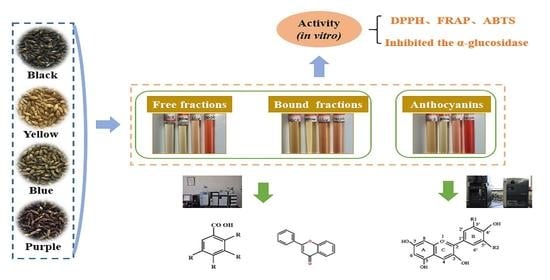Polyphenol and Anthocyanin Composition and Activity of Highland Barley with Different Colors
Abstract
:1. Introduction
2. Results and Discussion
2.1. Content of Phenolic Compounds in Barley
2.2. Composition and Content of Phenolic Compounds in Barley
2.2.1. Composition and Content of Phenolic Acids and Flavonoids in Barley of Different Colors
2.2.2. Composition and Content of Anthocyanin Compounds in Barley of Different Colors
2.3. In Vitro Antioxidant Activity of Phenolic Fractions from Different Varieties of Barley
2.3.1. In Vitro Antioxidant Activity of Phenolic Acids and Flavonoids
2.3.2. In Vitro Antioxidant Activity of Anthocyanin Fractions
2.4. Inhibition of Alpha-Glucosidase Activity In Vitro
2.5. Correlation Analysis
3. Materials and Methods
3.1. Material and Reagents
3.2. Research Procedures
3.2.1. Extraction of Free Phenolic Compounds from Barley
3.2.2. Extraction of Bound Phenolic Compounds from Barley
3.2.3. Extraction of Anthocyanins from Barley
3.2.4. Determination of Active Ingredients
- Determination of total phenolic compounds
- 2.
- Determination of total flavonoid content.
- 3.
- Determination of anthocyanin content.
3.2.5. Polyphenol Composition in Barley
- Composition and content determination of phenolic compounds in barley
- 2.
- Composition and Content Determination of Anthocyanins
3.2.6. Determination of Antioxidant Capacity
- Determination of DPPH’s radical scavenging capacity [42]
- 2.
- Ferric reducing antioxidant power assay.
- 3.
- Determination of radical scavenging capacity of ABTS ·
3.2.7. Inhibition of Alpha-Glucosidase Activity
3.2.8. Data Analysis
4. Conclusions
Author Contributions
Funding
Institutional Review Board Statement
Informed Consent Statement
Data Availability Statement
Acknowledgments
Conflicts of Interest
Sample Availability
References
- Guo, H.; Lin, S.; Lu, M.; Gong, J.D.B.; Wang, L.; Zhang, Q.; Wu, D.T. Characterization, in vitro binding properties, and inhibitory activity on pancreaticlipase of β-glucans from different Qingke (Tibetan hulless barley) cultivars. Int. J. Biol. Marker 2018, 120, 2517–2522. [Google Scholar]
- Tianli, G.; Carla, H.; Ling, C.; Jin, C.; Bo, Z. Understanding the nutrient composition and nutritional functions of highland barley (Qingke): A review. Trends Food Sci. Technol. 2020, 103, 109–117. [Google Scholar]
- Zhu, F.M.; Du, B.; Xu, B.J. Superfine grinding improves functional properties and antioxidant capacities of bran cdietary fibre from Qingke (Hull-less barley) grown in QinghaiTibet Plateau, China. J. Cereal Sci. 2015, 65, 43–47. [Google Scholar] [CrossRef]
- El, S.M.; Abdel, A.; Thin, M.C.; Simarata, D.; Iwona, R. Free and Bound Phenolic Acids and Total Phenolics in Black, Blue, and Yellow Barley and Their Contribution to Free Radical Scavenging Capacity. Cereal Chem. 2012, 89, 198–204. [Google Scholar]
- Lin, S.; Guo, H.; Duo, J.; Gong, B.; Lu, M.; Lu, M.Y.; Wang, L.; Zhang, Q.; Wen, Q.; Wu, D.T. Phenolic profiles, β-glucan contents, and antioxidant capacities of colored Qingke (Tibetan hulless barley) cultivars. J. Cereal Sci. 2018, 81, 69–75. [Google Scholar] [CrossRef]
- Yang, X.-J.; Dang, B.; Fan, M.-T. Free and Bound Phenolic Compound Content and Antioxidant Activity of Different Cultivated Blue Highland Barley Varieties from the Qinghai-Tibet Plateau. Molecules 2018, 23, 879. [Google Scholar] [CrossRef] [Green Version]
- Ge, X.; Jing, L.; Zhao, K.; Su, C.; Zhang, B.; Zhang, Q.; Han, L.; Yu, X.; Li, W. The phenolic compounds profile, quantitative analysis and antioxidant activity of four naked barley grains with different color. Food Chem. 2020, 335, 127655. [Google Scholar] [CrossRef]
- Aruoma, O.I. Free radicals, oxidative stress, and antioxidants in human health and disease. J. Am. Oil Chem. Soc. 1998, 75, 199–212. [Google Scholar] [CrossRef]
- Yu, L.; Haley, S.; Perret, J.; Harris, M.; Wilson, J.; Qian, M. Free Radical Scavenging Properties of Wheat Extracts. J. Agric. Food Chem. 2002, 50, 1619–1624. [Google Scholar] [CrossRef]
- Manach, C.; Scalbert, A.; Morand, C.; Rémésy, C.; Jiménez, L. Polyphenols: Food sources and bioavailability. Am. J. Clin. Nutr. 2004, 79, 727–747. [Google Scholar] [CrossRef] [Green Version]
- Gan, R.-Y.; Lui, W.-Y.; Wu, K.; Chan, C.-L.; Dai, S.-H.; Sui, Z.-Q.; Corke, H. Bioactive compounds and bioactivities of germinated edible seeds and sprouts: An updated review. Trends Food Sci. Technol. 2017, 59, 1–14. [Google Scholar] [CrossRef]
- Borneo, R.; León, A.E. Whole grain cereals: Functional components and health benefits. Food Funct. 2012, 3, 110–119. [Google Scholar] [CrossRef] [PubMed]
- Sumczynski, D.; Kotásková, E.; Družbíková, H.; Mlcek, J. Determination of contents and antioxidant activity of free and bound phenolics compounds and in vitro digestibility of commercial black and red rice (Oryza sativa L.) varieties. Food Chem. 2016, 211, 339–346. [Google Scholar] [CrossRef] [PubMed]
- Shen, Y.; Zhang, H.; Cheng, L.; Wang, L.; Qian, H.; Qi, X. In vitro and in vivo antioxidant activity of polyphenols extracted from black highland barley. Food Chem. 2015, 194, 1003–1012. [Google Scholar] [CrossRef]
- Zhu, Y.; Li, T.; Fu, X.; Abbasi, A.M.; Zheng, B.; Liu, R.H. Phenolics content, antioxidant and antiproliferative activities of dehulled highland barley (Hordeum vulgare L.). J. Funct. Foods 2015, 19, 439–450. [Google Scholar] [CrossRef]
- Himi, E.; Taketa, S. Isolation of candidate genes for the barley Ant1 and wheat Rc genes controlling anthocyanin pigmentation in different vegetative tissues. Mol. Genet. Genom. 2015, 290, 1287–1298. [Google Scholar] [CrossRef]
- Shoeva, O.Y.; Mock, H.-P.; Kukoeva, T.V.; Börner, A.; Khlestkina, E.K. Regulation of the Flavonoid Biosynthesis Pathway Genes in Purple and Black Grains of Hordeum vulgare. PLoS ONE 2016, 11, e0163782. [Google Scholar] [CrossRef]
- Yao, X.H.; Wu, K.L.; Yao, Y.H. Construction of a high-densitygenetic map: Genotyping by sequencing (GBS) to map purple seedcoat color (Psc) in hulless barley. Hereditas 2018, 55, 37. [Google Scholar] [CrossRef] [Green Version]
- Bellido, G.G.; Beta, T. Anthocyanin composition and oxygen radical scavenging capacity (ORAC) of milled and pearled purple, black, and common barley. J. Agric. Food Chem. 2009, 57, 1022–1028. [Google Scholar] [CrossRef]
- Adom, K.K.; Liu, R.H. Antioxidant Activity of Grains. J. Agric. Food Chem. 2002, 50, 6182–6187. [Google Scholar] [CrossRef]
- Wang, L.; Chen, J.; Xie, H.; Ju, X.; Liu, R.H. Phytochemical Profiles and Antioxidant Activity of Adlay Varieties. J. Agric. Food Chem. 2013, 61, 5103–5113. [Google Scholar] [CrossRef] [PubMed]
- Lahouar, L.; El Arem, A.; Ghrairi, F.; Chahdoura, H.; Ben Salem, H.; El Felah, M.; Achour, L. Phytochemical content and antioxidant properties of diverse varieties of whole barley (Hordeum vulgare L.) grown in Tunisia. Food Chem. 2014, 145, 578–583. [Google Scholar] [CrossRef] [PubMed]
- Adom, K.K.; Sorrells, M.E.; Liu, R.H. Phytochemical profilesand antioxidant activity of wheat varieties. J. Agric. Food Chem. 2003, 51, 7825–7834. [Google Scholar] [CrossRef] [PubMed]
- Ramakrishna, R.; Sarkar, D.; Schwarz, P.; Shetty, K. Phenolic linked antihyperglycemic bioactives of barley (Hordeum vulgare L.) cultivars as nutraceuticals targeting type 2 diabetes. Ind. Crop. Prod. 2017, 107, 509–517. [Google Scholar] [CrossRef]
- Lee, C.; Han, D.; Kim, B.; Baek, N.; Baik, B.-K. Antioxidant and anti-hypertensive activity of anthocyanin-rich extracts from hulless pigmented barley cultivars. Int. J. Food Sci. Technol. 2012, 48, 984–991. [Google Scholar] [CrossRef]
- Šimić, G.; Horvat, D.; Dvojković, K.; Abičić, I.; Vuletić, M.V.; Tucak, M.; Lalić, A. Evaluation of total phenolic content and antioxidant activity of malting and hulless barley grain and malt extracts. Czech J. Food Sci. 2017, 35, 73–78. [Google Scholar] [CrossRef] [Green Version]
- Zielin´ski, H.; Kozłowska, H. Antioxidant activity and total phenolic in selected cereals grains and their different morphological fractions. J. Agric. Food Chem. 2000, 48, 2008–2016. [Google Scholar] [CrossRef]
- Kruma, Z.; Tomsone, L.; Galoburda, R.; Straumite, E.; Ssveen, M. Total phenols and antioxidant capacity of hull-less barley and hull-less oats. Agron. Res. 2016, 14, 1361–1371. [Google Scholar]
- Zhigang, H.; Jingjie, Z.; Shengguan, C.; Xiaohui, C.; Xiaoyan, Q.; Guoping, Z. Association mapping for total polyphenol con-tent, total flavonoid content and antioxidant activity in barley. BMC Genom. 2018, 19, 81. [Google Scholar]
- Zhang, T.W.; Ma, J.L.; Wu, X.L.; Hao, Z.H.; Dun, C.; Chen, C. Qualitative and semi-quantitative assessment of anthocya-nins in Tibetan hullessbarley from different geographical locations by UPLC-QTOF-MS and their antioxidant capacities. Open Chem. 2021, 19, 1–8. [Google Scholar] [CrossRef]
- Zhang, Y.; Yin, L.; Huang, L.; Tekliye, M.; Xia, X.; Li, J.; Dong, M. Composition, antioxidant activity, and neuroprotective effects of anthocyanin-rich extract from purple highland barley bran and its promotion on autophagy. Food Chem. 2020, 339, 127849. [Google Scholar] [CrossRef] [PubMed]
- Kim, M.J.; Hyun, J.N.; Kim, J.A. Relationship between phenolic compounds, anthocyanins content and antioxidant activity in colored barley germplasm. J. Agric. Food Chem. 2007, 55, 4802. [Google Scholar] [CrossRef] [PubMed]
- Hu, Q.-P.; Xu, J.-G. Profiles of Carotenoids, Anthocyanins, Phenolics, and Antioxidant Activity of Selected Color Waxy Corn Grains during Maturation. J. Agric. Food Chem. 2011, 59, 2026–2033. [Google Scholar] [CrossRef] [PubMed]
- Padhi, S.; Nayak, A.K.; Behera, A. Type II diabetes mellitus: A review on recent drug based therapeutics. Biomed. Pharm. 2020, 131, 110708. [Google Scholar] [CrossRef]
- Qiu, C.; Chang, R.; Yang, J.; Ge, S.; Xiong, L.; Zhao, M.; Li, M.; Sun, Q. Preparation and characterization of essential oil-loaded starch nanoparticles formed by short glucan chains. Food Chem. 2017, 221, 1426–1433. [Google Scholar] [CrossRef]
- Ervina, M.; Lie, H.S.; Diva, J.; Caroline; Tewfik, S.; Tewfik, I. Optimization of water extract of Cinnamomum burmannii bark to ascertain its in vitro antidiabetic and antioxidant activities. Biocatal. Agric. Biotechnol. 2019, 19, 101152. [Google Scholar] [CrossRef]
- Pradeep, P.; Sreerama, Y.N. Phenolic antioxidants of foxtail and little millet cultivars and their inhibitory effects on α-amylase and α-glucosidase activities. Food Chem. 2018, 247, 46–55. [Google Scholar] [CrossRef]
- Bellesia, A.; Tagliazucchi, D. Cocoa brew inhibits in vitro α-glucosidase activity: The role of polyphenols and high molecular weight compounds. Food Res. Int. 2014, 63, 439–445. [Google Scholar] [CrossRef]
- Zhao, H.; Dong, J.; Lu, J.; Chen, J.; Li, Y.; Shan, L.; Lin, Y.; Fan, A.W.; Gu, G. Effects of Extraction Solvent Mixtures on Antioxidant Activity Evaluation and Their Extraction Capacity and Selectivity for Free Phenolic Compounds in Barley (Hordeum vulgare L.). J. Agric. Food Chem. 2006, 54, 7277–7286. [Google Scholar] [CrossRef]
- Moza, J.; Gujral, H.S. Starch digestibility and bioactivity of high altitude hulless barley. Food Chem. 2016, 194, 561–568. [Google Scholar] [CrossRef]
- Liu, K.; Xiao, X.; Wang, J.; Chen, C.-Y.O.; Hu, H. Polyphenolic composition and antioxidant, antiproliferative, and antimicrobial activities of mushroom Inonotus sanghuang. LWT 2017, 82, 154–161. [Google Scholar] [CrossRef] [Green Version]
- Shao, Y.; Xu, F.; Sun, X.; Bao, J.; Beta, T. Identification and quantification of phenolic acids and anthocyanins as antioxidants in bran, embryo and endosperm of white, red and black rice kernels (Oryza sativa L.). J. Cereal Sci. 2014, 59, 211–218. [Google Scholar] [CrossRef]
- Pang, Y.; Ahmed, S.; Xu, Y.; Beta, T.; Zhu, Z.; Shao, Y.; Bao, J. Bound phenolic compounds and antioxidant properties of whole grain and bran of white, red and black rice. Food Chem. 2018, 240, 212–221. [Google Scholar] [CrossRef]
- Yang, M.; Shen, Q.; Li, L.-Q.; Huang, Y.-Q.; Cheung, H.-Y. Phytochemical profiles, antioxidant activities of functional herb Abrus cantoniensis and Abrus mollis. Food Chem. 2015, 177, 304–312. [Google Scholar] [CrossRef] [PubMed]
- Yang, X.; Kong, F. Evaluation of the in vitro α-glucosidase inhibitory activity of green tea polyphenols and different tea types. J. Sci. Food Agric. 2015, 96, 777–782. [Google Scholar] [CrossRef] [PubMed]

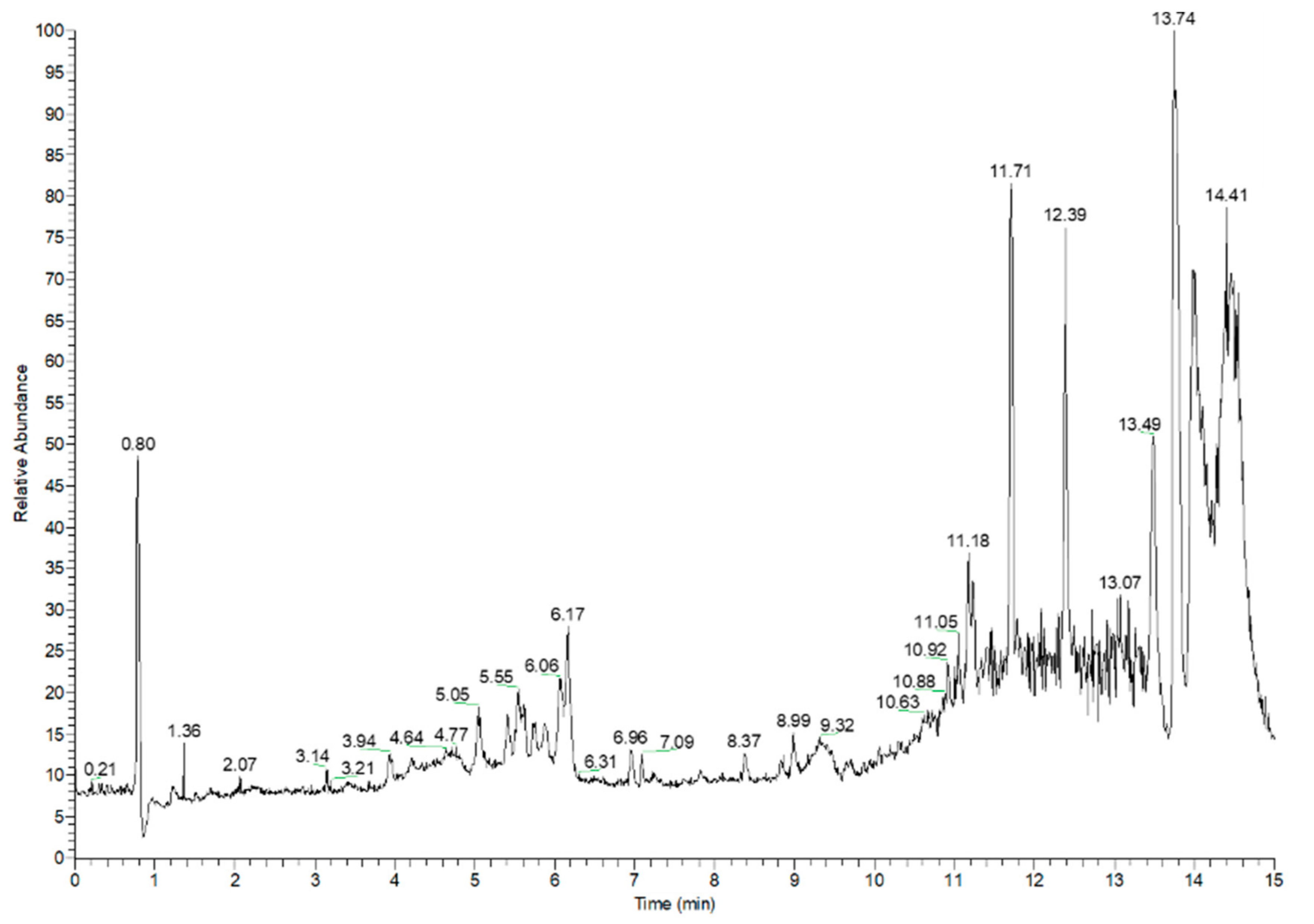

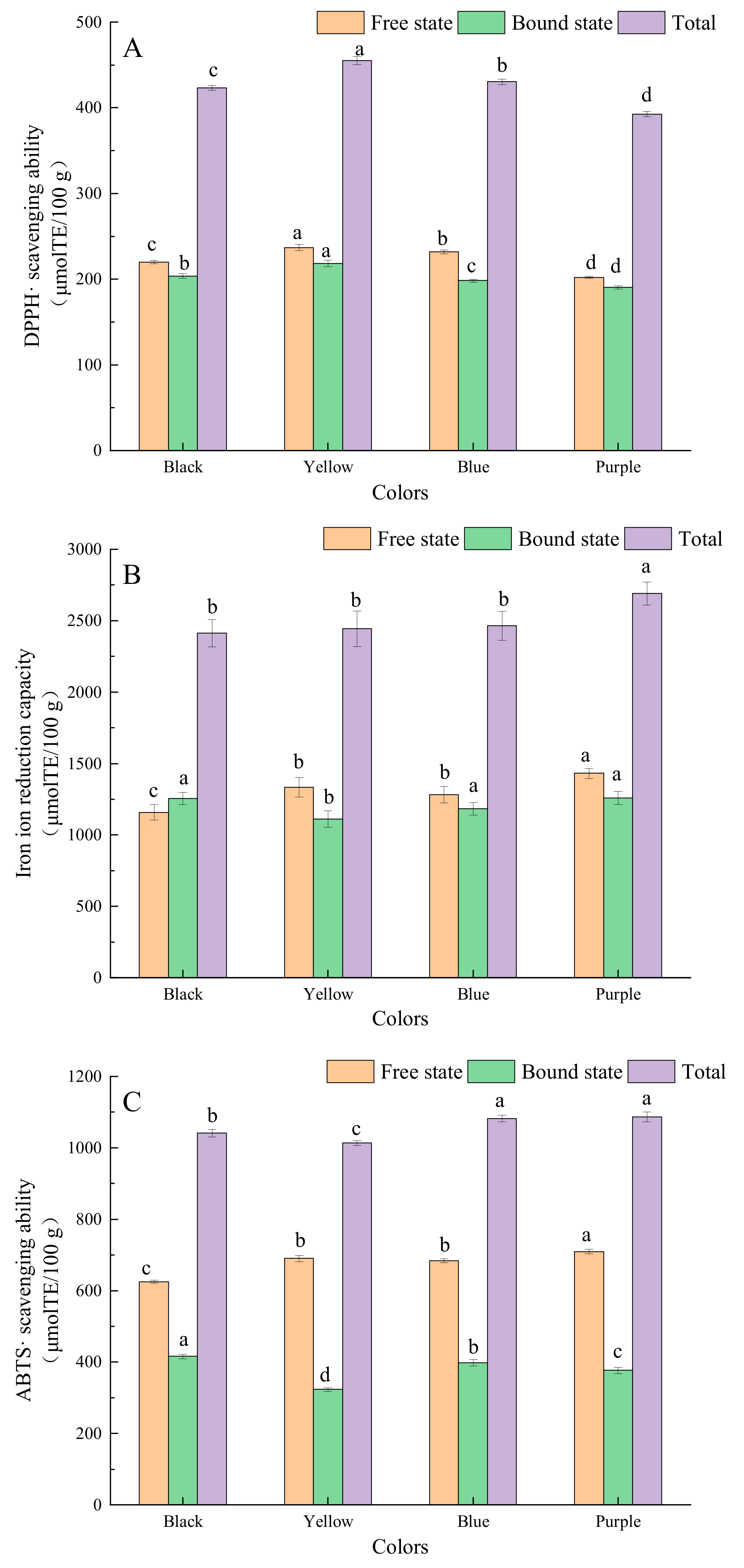
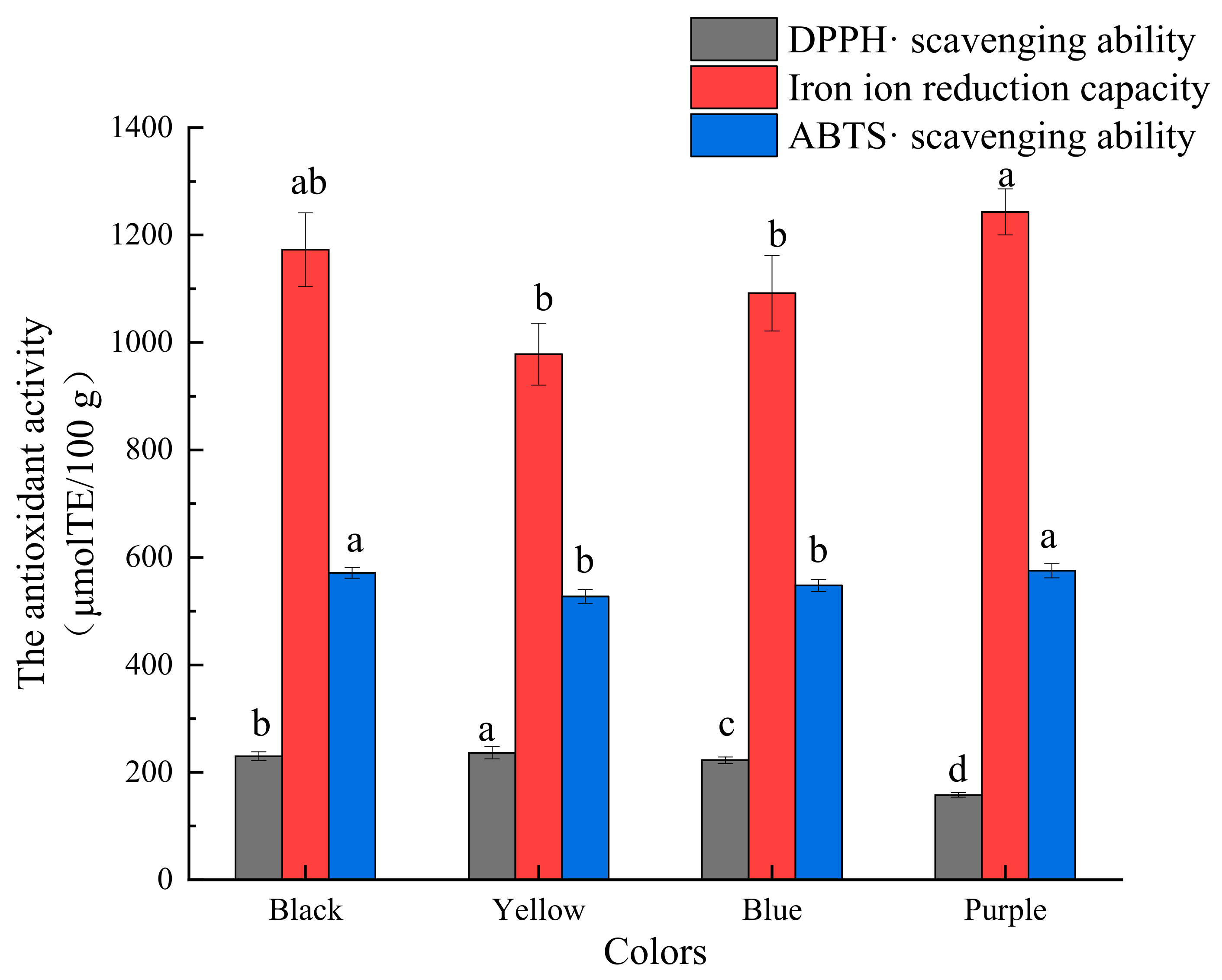
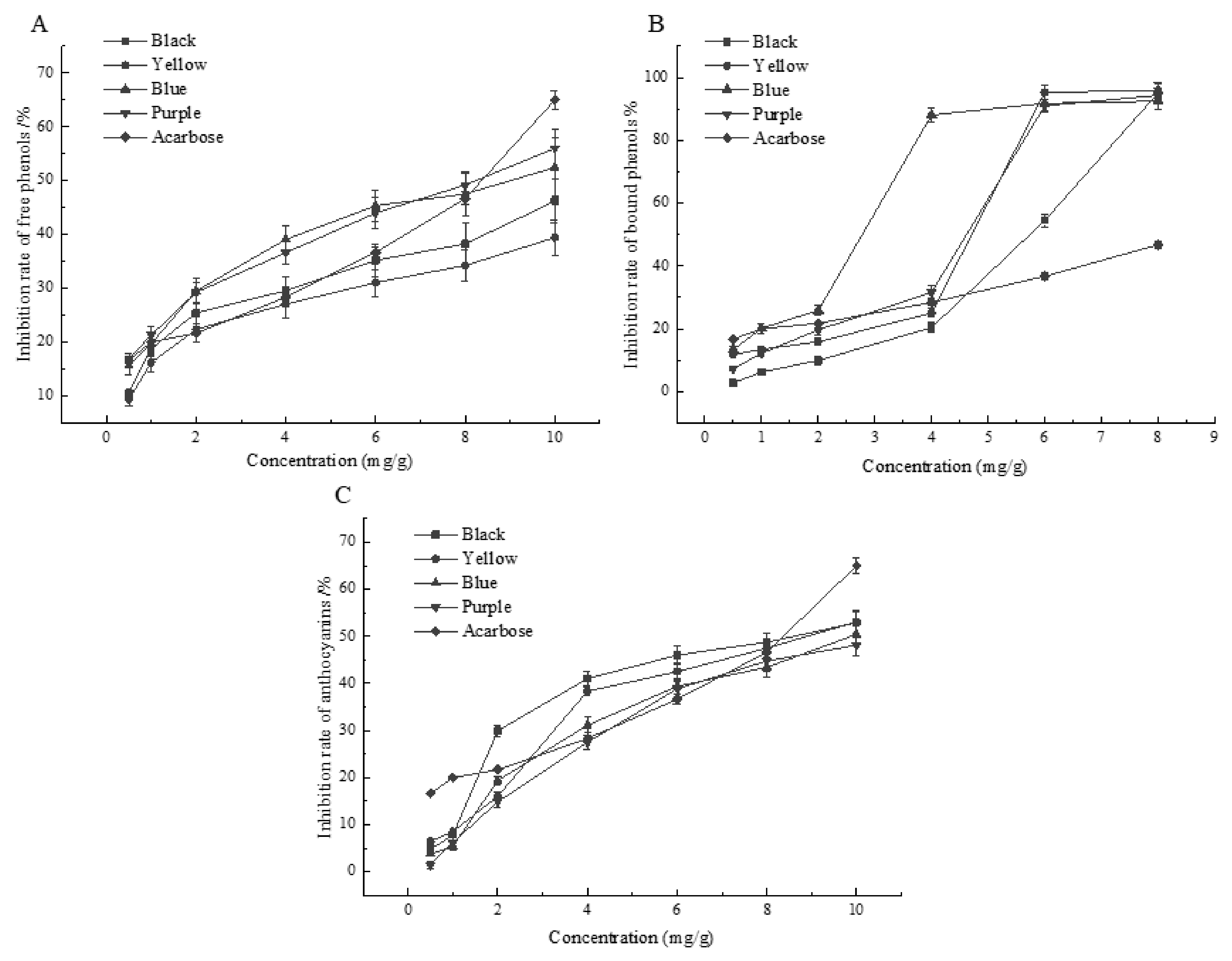
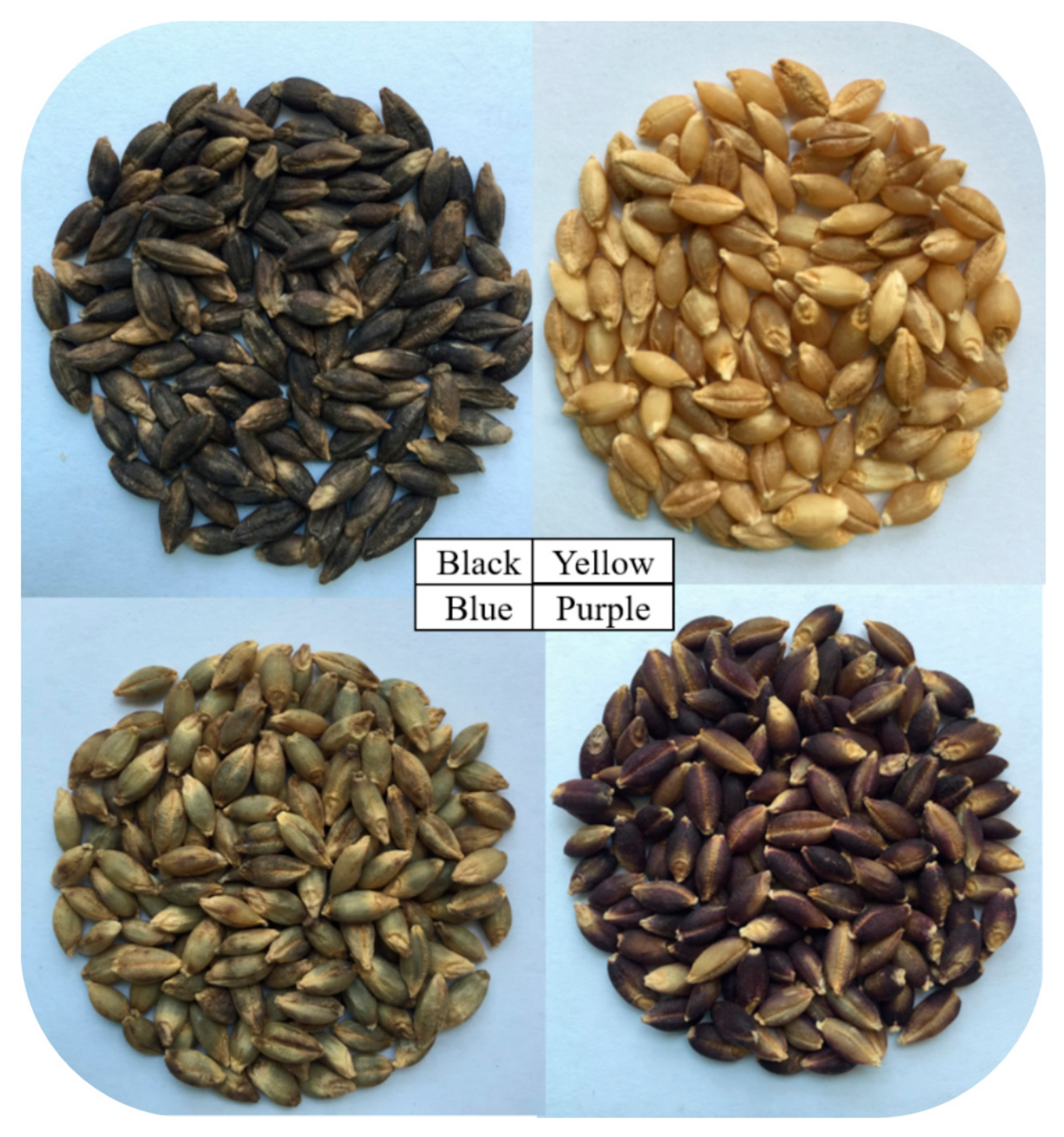
| Colors | Black | Yellow | Blue | Purple |
|---|---|---|---|---|
| Free phenolic compounds | 165.09 ± 5.17 Bc | 210.32 ± 8.21 Bb | 214.49 ± 8.84 Bb | 264.26 ± 19.14 Ba |
| Bound phenolic compounds | 344.35 ± 13.17 Aa | 305.4 ± 13 Ab | 327.79 ± 19.86 Ab | 306.53 ± 5.36 Ab |
| Total phenolic compounds | 509.44 ± 15.76 b | 515.72 ± 18.57 b | 542.28 ± 26.51 ab | 570.78 ± 18.83 a |
| Free flavonoids | 29.93 ± 2.64 Aa | 25.87 ± 1.9 Ab | 27.18 ± 2.31 Ab | 27.74 ± 1.71 Ab |
| Bound flavonoids | 15.6 ± 2 Bab | 12.17 ± 2.53 Bb | 11.29 ± 0.76 Bb | 19.33 ± 5.64 Ba |
| Total flavonoids | 45.53 ± 4.56 a | 38.04 ± 4.34 b | 38.47 ± 2.97 a | 47.08 ± 6.17 a |
| Anthocyanins | 41.91 ± 0.13 a | 38.09 ± 0.06 a | 33.53 ± 5.07 b | 48.07 ± 8.73 a |
| Types | Black Variety | Yellow Variety | Blue Variety | Purple Variety | |||||
|---|---|---|---|---|---|---|---|---|---|
| Free | Bound | Free | Bound | Free | Bound | Free | Bound | ||
| Phenolic acid | |||||||||
| Benzoic acids | Gallic acid | ND | ND | ND | 33.365 ± 0.487 a | ND | ND | ND | 15.879 ± 0.936 b |
| Protocatechuic acid | 4.044 ± 0.037 a | ND | 1.831 ± 0.018 c | ND | 2.377 ± 0.052 b | ND | ND | ND | |
| 2,4-Dihydroxybenzoic acid | ND | ND | ND | 1.458 ± 0.082 a | 1.317 ± 0.049 a | ND | 0.879 ± 0.024 b | ND | |
| Vanillic acid | 2.9 ± 0.105 a | ND | ND | ND | ND | 1.065 ± 0.074 a | ND | ND | |
| Syringic acid | ND | 74.926 ± 1.016 b | ND | 116.901 ± 2.056 a | ND | 0.799 ± 0.014 d | ND | 25.638 ± 0.745 c | |
| Salicylic acid | 0.733 ± 0.09 b | 1.3 ± 0.049 b | 0.773 ± 0.046 b | 1.483 ± 0.013 ab | 0.847 ± 0.026 b | 0.89 ± 0.033 c | 1.105 ± 0.013 a | 1.738 ± 0.036 a | |
| Benzoic acid | 1.096 ± 0.015 a | 84.454 ± 0.405 b | ND | 140.898 ± 1.081 a | 0.818 ± 0.013 b | 2.699 ± 0.026 d | ND | 29.596 ± 1.157 c | |
| Veratric acid | 1.795 ± 0.033 b | 11.78 ± 0.18 a | ND | 0.993 ± 0.017 d | ND | 4.332 ± 0.031 c | 2.051 ± 0.077 a | 8.442 ± 0.088 b | |
| Cinnamic acid | O-coumaric acid | 1.603 ± 0.021 a | 3.614 ± 0.016 a | ND | 2.267 ± 0.099 bc | ND | 1.812 ± 0.039 c | ND | 1.929 ± 0.024 c |
| Chlorogenic acid | 7.279 ± 0.26 a | ND | 4.085 ± 0.162 b | ND | 3.681 ± 0.165 b | 6.155 ± 0.8 a | ND | ND | |
| p-coumaric acid | ND | 11.922 ± 0.779 c | ND | 14.1 ± 0.322 b | ND | 583.539 ± 2.248 a | 1.675 ± 0.044 a | 6.912 ± 0.14 d | |
| Ferulic acid | ND | 1.01 ± 0.023 ab | ND | 1.08 ± 0.05 ab | ND | 1.274 ± 0.05 a | ND | 0.762 ± 0.007 b | |
| Total | 19.450 ± 0.335 a | 189.006 ± 1.323 c | 6.689 ± 0.565 c | 312.544 ± 2.165 b | 9.040 ± 0.191 b | 602.565 ± 2.097 a | 5.710 ± 0.041 c | 90.900 ± 1.745 d | |
| Total phenolic acid | 208.456 ± 2.034 c | 319.233 ± 1.483 b | 611.605 ± 2.656 a | 96.605 ± 1.023 d | |||||
| Flavone | |||||||||
| Hesperidin | Naringin | ND | 0.668 ± 0.015 c | ND | 8.066 ± 0.115 a | 0.794 ± 0.005 b | 6.178 ± 0.104 b | 1.832 ± 0.036 a | 1.131 ± 0.029 c |
| Flavanol | Catechin | 6.458 ± 0.145 a | 3.225 ± 0.097 a | 5.693 ± 0.198 b | ND | ND | ND | ND | 3.53 ± 0.373 a |
| Chalcone | Phloretin | 33.078 ± 0.164 a | 1.047 ± 0.073 b | ND | ND | ND | ND | 1.324 ± 0.078 b | 3.895 ± 0.147 a |
| Flavanone | Hesperidin | ND | 5.564 ± 0.26 b | ND | 0.704 ± 0.005 d | ND | 2.002 ± 0.065 c | 2.856 ± 0.074 a | 9.688 ± 0.059 a |
| Naringenin | 0.724 ± 0.036 a | 5.31 ± 0.126 c | 0.616 ± 0.05 b | 4.728 ± 0.066 c | 0.625 ± 0.007 b | 50.145 ± 1.156 a | 0.698 ± 0.018 b | 8.547 ± 0.151 b | |
| Flavonol | Myricetin | ND | 0.992 ± 0.029 c | ND | 3.851 ± 0.049 b | ND | 8.38 ± 0.737 a | ND | 0.672 ± 0.005 c |
| Quercetin | ND | 3.084 ± 0.045 c | 1.798 ± 0.091 b | 8.055 ± 0.129 b | ND | 24.798 ± 1.168 a | 8.356 ± 0.977 a | 3.729 ± 0.109 c | |
| Kaempferol | 1.396 ± 0.485 b | 3.499 ± 0.044 b | 1.407 ± 0.015 a | 2.602 ± 0.028 c | ND | 6.991 ± 0.179 a | 1.404 ± 0.059 a | 2.037 ± 0.002 c | |
| Rutin | 1.086 ± 0.267 c | 4.666 ± 0.726 b | 1.655 ± 0.096 b | 3.769 ± 0.045 c | 1.288 ± 0.078 c | 5.241 ± 0.884 a | 3.287 ± 0.504 a | 3.22 ± 0.303 c | |
| Total | 42.742 ± 0.986 a | 28.054 ± 0.307 d | 11.169 ± 0.064 c | 31.775 ± 1.016 c | 2.707 ± 0.044 d | 103.735 ± 1.017 a | 19.756 ± 1.107 b | 36.450 ± 1.152 b | |
| Total flavone | 70.796 ± 0.898 b | 42.944 ± 0.906 d | 106.442 ± 1.06 a | 56.206 ± 0.336 c | |||||
| Total | 62.192 ± 2.632 a | 217.06 ± 1.614 c | 17.858 ± 0.161 c | 344.319 ± 2.13 b | 11.747 ± 0.999 d | 706.3 ± 2.145 a | 25.466 ± 1.215 b | 127.346 ± 2.388 d | |
| Total phenol + total flavonoids | 279.252 ± 2.426 c | 362.178 ± 2.208 b | 718.047 ± 3.021 a | 152.811 ± 1.103 d | |||||
| Types | Black Variety | Yellow Variety | Blue Variety | Purple Variety |
|---|---|---|---|---|
| Cyanidin | 0.630 ± 0.01 b | 0.810 ± 0.002 b | 1.647 ± 0.057 a | 1.772 ± 0.002 a |
| Cyanidin-3-glucoside | 1.301 ± 0.044 c | 1.267 ± 0.013 c | 10.659 ± 0.088 b | 96.874 ± 0.783 a |
| Delphinidin | 1.148 ± 0.062 b | 1.267 ± 0.051 b | 3.269 ± 0.062 a | 3.273 ± 0.076 a |
| Delphinidin-3-glucoside | 3.013 ± 0.179 a | 0.110 ± 0.074 b | 3.879 ± 0.098 a | ND |
| Malvidin | ND | ND | ND | ND |
| Malvidin-3-glucoside | 0.396 ± 0.004 b | ND | 0.621 ± 0.039 a | 0.297 ± 0.071 b |
| Pelargonidin | ND | ND | ND | ND |
| Pelargonidin-3-glucoside | 0.101 ± 0.021 bc | 0.104 ± 0.004 bc | 0.635 ± 0.033 b | 2.015 ± 0.091 a |
| Peonidin | ND | 0.280 ± 0.006 a | 0.201 ± 0.022 b | 0.236 ± 0.005 ab |
| Peonidin-3-glucoside | ND | ND | ND | ND |
| Petunidin | 0.405 ± 0.064 a | 0.497 ± 0.019 a | 0.508 ± 0.054 a | 0.271 ± 0.008 b |
| Petunidin-3-glucoside | 1.496 ± 0.025 b | 0.077 ± 0.004 d | 6.004 ± 0.196 a | 0.475 ± 0.008 c |
| Total | 8.492 ± 0.83 c | 4.413 ± 0.442 d | 27.422 ± 0.635 b | 105.213 ± 2.514 a |
| Iron Ion Reduction Capacity | ABTS · Scavenging Ability | DPPH · Scavenging Ability | IC50 Value for Inhibition of Alpha-Glucosidase Activity | ||
|---|---|---|---|---|---|
| Free phenolic fractions | Total phenolic acid content | 0.996 ** | |||
| Total cinnamic acids | 0.982 * | ||||
| Vanillic acid | 0.969 * | ||||
| o-coumaric acid | 0.969 * | ||||
| Protocatechuic acid | −0.994 ** | ||||
| Chlorogenic acid | −0.963 * | ||||
| Phloretin | 0.960 * | ||||
| Bound phenolic fractions | Gallic acid | −0.968 * | |||
| Benzoic acid | 0.961 * | ||||
| Pelargonidin-3-glucoside | 0.961 * |
Publisher’s Note: MDPI stays neutral with regard to jurisdictional claims in published maps and institutional affiliations. |
© 2022 by the authors. Licensee MDPI, Basel, Switzerland. This article is an open access article distributed under the terms and conditions of the Creative Commons Attribution (CC BY) license (https://creativecommons.org/licenses/by/4.0/).
Share and Cite
Jin, H.-M.; Dang, B.; Zhang, W.-G.; Zheng, W.-C.; Yang, X.-J. Polyphenol and Anthocyanin Composition and Activity of Highland Barley with Different Colors. Molecules 2022, 27, 3411. https://doi.org/10.3390/molecules27113411
Jin H-M, Dang B, Zhang W-G, Zheng W-C, Yang X-J. Polyphenol and Anthocyanin Composition and Activity of Highland Barley with Different Colors. Molecules. 2022; 27(11):3411. https://doi.org/10.3390/molecules27113411
Chicago/Turabian StyleJin, Hui-Min, Bin Dang, Wen-Gang Zhang, Wan-Cai Zheng, and Xi-Juan Yang. 2022. "Polyphenol and Anthocyanin Composition and Activity of Highland Barley with Different Colors" Molecules 27, no. 11: 3411. https://doi.org/10.3390/molecules27113411
APA StyleJin, H.-M., Dang, B., Zhang, W.-G., Zheng, W.-C., & Yang, X.-J. (2022). Polyphenol and Anthocyanin Composition and Activity of Highland Barley with Different Colors. Molecules, 27(11), 3411. https://doi.org/10.3390/molecules27113411




